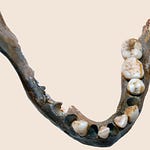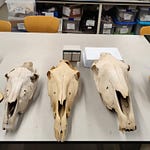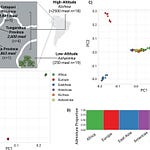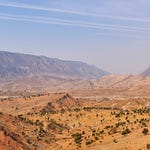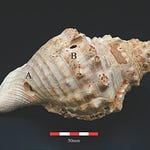In the deep time of Arabia’s human past, long before cities, scripts, or sultans, small groups of herders raised stones in the desert. These weren’t grand temples or sprawling cities. They were modest monuments—platforms, triliths, tombs—scattered across Oman’s Dhofar region. Yet they anchored communities, offering a social compass in a world growing ever more uncertain.
A new study published in PLOS ONE1 reconstructs 7,000 years of monument building in southern Arabia and argues that these humble stone structures represent more than funerary rites or territorial markers. They were resilient technologies—architectural responses to the changing social and ecological pressures of an increasingly arid world.

A Landscape of Memory and Survival
Platforms of Plenty
The oldest monuments in this record—massive sub-circular stone platforms—date back to the Holocene Humid Period (10,000–6,000 years ago), a time when monsoon rains fed inland lakes and seasonal grasslands bloomed along escarpments.
To build such a platform, stones weighing hundreds of kilograms had to be hoisted and balanced, often requiring “at least seven strong men,” the authors note. The sheer labor involved suggests coordinated gatherings of multiple families or herding groups.
"These large monuments that were built in one episode could only be built early on, before the region became arid," said lead author Joy McCorriston. "This is when large groups of people could still come together at one time."
These weren’t just functional structures. They signaled participation in a larger social fabric—monuments built during periodic feasts, ritual events, or clan gatherings, much like megaliths in prehistoric Europe or East African stone circles.
From Feast to Fragment
After about 6,000 years ago, rainfall across Arabia began to decline. Desertification intensified by 2,700 years ago. Water grew scarcer, forage patchier. Populations dispersed.
The archaeological record reflects this shift. Monument construction continued—but at smaller scales. The next major type, the “HCT” or high circular tomb, used fewer and smaller stones, suggesting that builders worked in smaller groups, likely under more constrained conditions. These tombs weren’t just burials; they were social anchors for thinning pastoral networks.
"The appearance of Bronze Age tombs suggests that resilient people now forged social identities and mediated access to resources through kinship with memorialized dead," the authors explain.
The architecture of resilience evolved again with triliths—simple triads of upright stones built into low gravel mounds. Unlike the earlier monuments, triliths were constructed incrementally, often by separate groups over time.
"In many cases, they were building a memory. They come to a monument and add their piece, which was a replicated element of the whole. It helped people maintain a community, even with those they may rarely see," McCorriston explains.
Engineering Social Belonging
When Climate Frays the Social Fabric
What makes this study stand out is its scale: a dataset of 371 monuments analyzed not just archaeologically, but environmentally. Using machine learning and statistical modeling, the team linked monument types to local conditions—vegetation density, slope, proximity to springs, and fog moisture.
The oldest monuments hugged the lowlands and clustered near water. Later triliths scattered across barren uplands. The newer they were, the farther they strayed from predictable resources.
Yet even in these sparse landscapes, the act of monument-building continued. People came, hauled stones, and left behind a social imprint.
"Monuments communicate a culturally specific, shared meaning from builders to contemporaries and facilitate exchange and social relationships," the authors write.
A Broader Lens on Monumentality
Rather than interpreting each structure in isolation—grave, marker, altar—this study proposes a holistic model: monuments as adaptive technologies. Their form and frequency shifted with population density, mobility, and environmental pressure.
In this way, Arabia’s prehistoric pastoralists weren't simply reacting to climate change; they were innovating socially. They developed architectures of memory, cooperation, and identity suited to life in motion.
McCorriston and colleagues argue that their findings could extend beyond Arabia.
"Our model highlights a reliance on monuments to preserve connections and adapt socially in a changing world."
Related Research and Citations
Costanzo, S., Brandolini, F., Idriss Ahmed, H., Zerboni, A., & Manzo, A. (2021). Creating the funerary landscape of eastern Sudan. PLOS ONE, 16(7), e0253511. https://doi.org/10.1371/journal.pone.0253511
Dalton, M., et al. (2021). The middle Holocene ‘funerary avenues’ of north-west Arabia. The Holocene, 32(3), 183–199. https://doi.org/10.1177/09596836211060497
Linares Matás, G. J. (2023). Memory, agency, and labor mobilization in the monumental funerary landscapes of southeastern Mauritania, West Africa. Journal of Anthropological Archaeology, 70, 101488. https://doi.org/10.1016/j.jaa.2023.101488
Harrower, M. J., & McCorriston, J. (2012). Water Histories and Spatial Archaeology: Ancient Yemen and the American West. Geoforum, 43(3), 573–586. https://doi.org/10.1016/j.geoforum.2011.10.007
McCorriston, J., Ball, L., Harrower, M. J., Hamilton, I. M., Ivory, S. J., Senn, M. J., Steimer-Herbet, T., Buffington, A. F., Al-Kathiri, A. A., & Al-Mahri, A. M. (2025). South Arabia’s prehistoric monument landscape shows social resilience to climate change. PloS One, 20(5), e0323544. https://doi.org/10.1371/journal.pone.0323544



